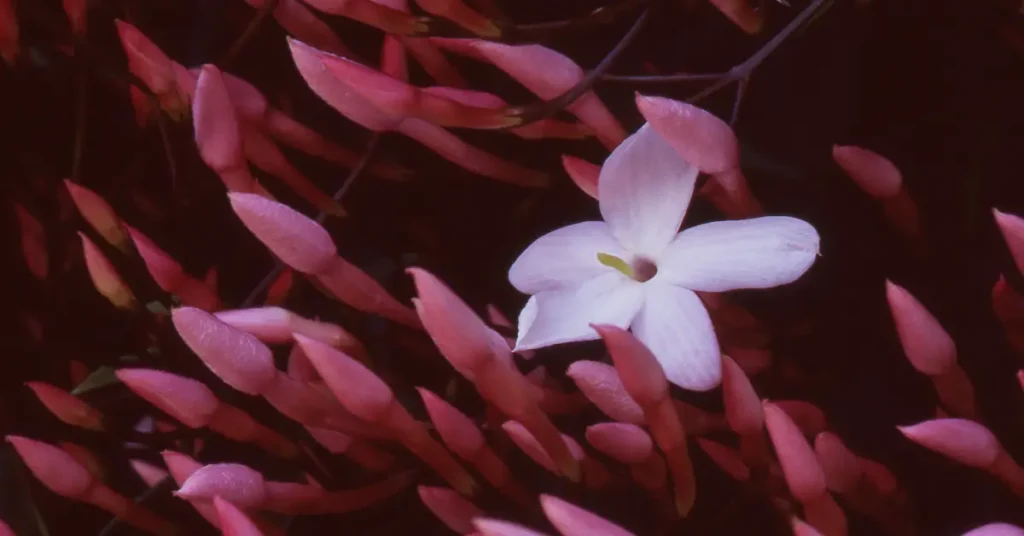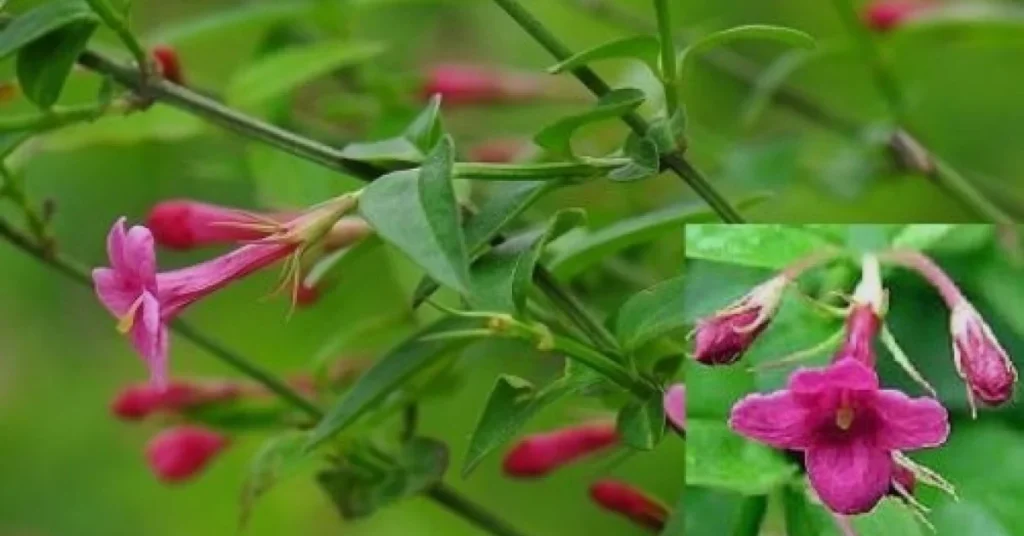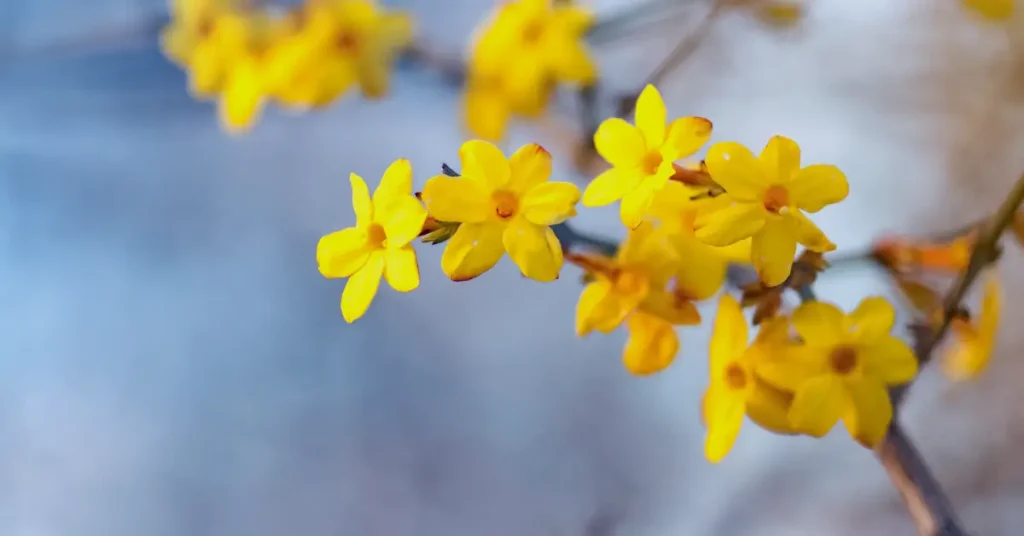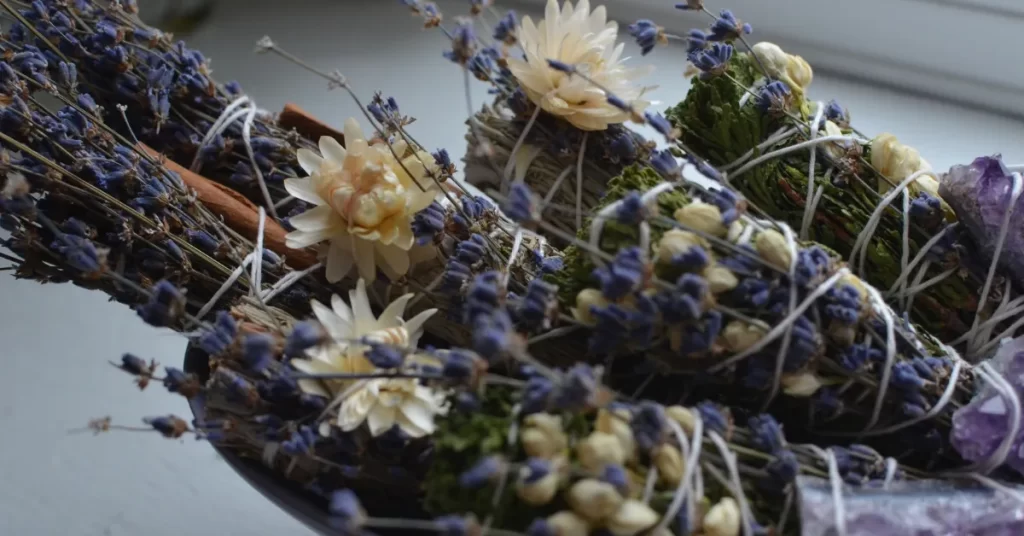Primrose Jasmine (Jasminum Mesnyi)-Japanese Jasmine
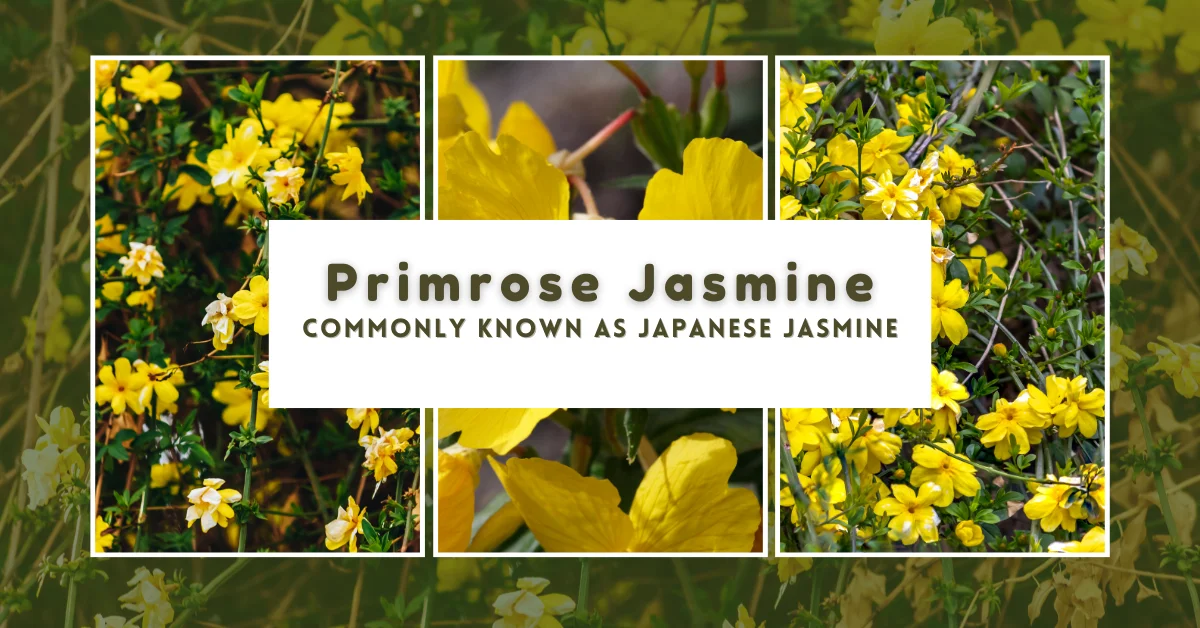
Commonly known as Japanese Jasmine, the Primrose Jasmine is a robust, fountain-like, arched shrub that sends out long shoots, a good climbing plant if supported. It is commonly used on highway medians because it tends to grow quickly, drought tolerant, and is all-around hardy. It usually grows wider than tall, with an open, sprawling habit. When grown along fence lines and walls, it can reach greater heights (10 ft). In contrast to most plants, the green stems are square rather than round, and the leaves have three leaflets.
The best time to prune primrose is in the winter when new growth has emerged and old foliage has been removed. Early in the spring, the shrub is covered with semi-double blooms of a slightly fragrant yellow color. It blooms in spring and summer in masses of bright yellow blooms with a light scent.
You have choices to train shoots to climb, plant next to a wall, or leave unsupported to grow as a sprawling shrub. Its easy-going nature and year-round low maintenance make Primrose Jasmine a favorite among gardeners. This article outlines the characteristics, care, cultivation, and uses of Primrose Jasmine.
Characteristics Primrose Jasmine
| Botanical Name | Jasminum mesnyi |
| Common Name | Japanese Jasmine, Weeping Jasmine |
| Family | Oleaceae |
| Flower Color | Yellow |
| Sun Exposure | Full sun to partial shade |
| Bloom Time | Spring, Summer |
| Soil Type | Well-draining, loamy soil |
Features of Primrose Jasmine
Gardeners love primrose jasmine for its distinctive features. Its key characteristics are as follows:
Bright Yellow Flowers: Late winter to early spring, yellow flowers appear on the plant in clusters. Even though this jasmine specie isn’t as fragrant as most others like Arabian Jasmine, Spanish Jasmine, Common Jasmine and Pink Jasmine, but its vibrant color makes up for it.
Evergreen Foliage: Its glossy, dark green leaves provide year-round interest and a lush backdrop regardless of whether it is in bloom.
Arching Branches: Plants grow in a cascading manner, creating an arching habit that is particularly striking when spilling over walls or fences.
Rapid Growth: Primrose jasmine is a fast-growing plant that is excellent for covering unsightly structures and filling in gaps in the garden.
Primrose Jasmine Care
To keep Primrose Jasmine vibrant and flourishing, proper care and maintenance is essential. With proper care of watering, sunlight, temperature, and soil requirements, Primrose Jasmine can thrive and produce beautiful, fragrant blooms.
Watering
Ideally, primrose jasmine needs moderate humidity and well-drained soil similar to its native subtropical habitat. Once established, it tolerates drought well but prefers consistent moisture, which requires watering once every two weeks. Primrose jasmine performs best outdoors when it receives sufficient rain during its growing season, which ensures a balance between hydration and drainage.
During the first growing season, new plants require weekly watering, depending on rainfall. During hot spells, soak the ground thoroughly every few days instead of watering daily. Roots grow deeper into the ground when watered deeply, making plants drought-tolerant. You can check the moisture level by poking a hole in the soil or using a hand trowel.
The first 2-4″ (5-10cm) of soil should be watered if it is dry. Make sure that new plants get enough moisture during their first two years.Then, they should be able to survive on their own.
Sunlight Requirements
The primrose jasmine thrives in either full or partial sunlight (2-6 hours a day). With more sunlight, it usually produces more flowers. When the weather is warmer, indoor plants benefit from regular exposure to direct sunlight. You can take them outside for some sun now and then.
Avoid sunburn and excessive heat in hotter climates.Too much shade, however, can result in fewer blooms and leggier growth.
Temperature Range
Primrose jasmine thrives in slightly warmer, humid climates. Ideal temperatures range from 15 to 25°C. I always advise gardeners to choose varieties based on local conditions. Most varieties can tolerate temperatures below 5 °C after the first bloom.
It will help primrose jasmine bloom more quickly in spring by keeping temperatures within these limits. Primrose jasmine roots prefer slightly drier soil. When grown as a houseplant, it does not thrive in overly moist soil. Allow the soil to dry between waterings. A lack or excess of moisture may cause yellowing or browning of delicate petals.
Soil Requirements
Primrose jasmine generally tolerates a wide range of soils as long as they are sufficiently well drained and have a neutral pH. Drain the soil well to prevent waterlogging and root rot.
Add organic matter to the soil, such as compost to improve its structure. The potting mix should contain equal amounts of potting soil, peat moss, and sand if planted in a container. Different varieties prefer different types of soil (sandy, loamy, clay). It prefers a pH level between 6.0 and 7.0. Assess the soil pH and amend as necessary.
Is Primrose Jasmine Poisonous?
It is non-toxic. However, There is need to check the quantity taken. If taken in large quantities, it may cause gastrointestinal problems. It is better to avoid kids and pets intake.
Growing Primrose Jasmine
Cultivation
Plant Primrose Jasmine in the spring or fall when temperatures are mild. It grows best outdoors in frost-free, well-drained soil. Allow roots and branches to grow freely. Plants should be spaced enough away from foundations, walls, and decks to avoid crowding the structure.
Make a hole twice the width of the root ball and slightly deeper. Put the plant in the hole, and fill it with soil and water thoroughly to settle the soil around the roots. The burlap fabric wrapped around the root ball must be removed along with any strings or wires that secure it.
Rub your fingers across the roots if they are tightly packed. Place the soil around the root ball and pack it firmly around it. Ensure that the soil line is just above where a plant’s roots flare out from its main stem.
Propagation
The easiest way to propagate it is with healthy, non-flowering cuttings that have a few leaves on them. Encourage growth by dipping the cut end in the rooting hormone. Keep cuttings in indirect light and in a moist, well-draining potting mixture. Ensure that the soil is consistently moist and maintain a warm environment to promote root growth. When grown with patience and care, primrose jasmine will establish new growth and reward cultivators with vibrant blooms.
Pruning
Plant care involves pruning to remove dead branches, enhance bushier growth, encourage more flowers, or maintain certain shapes and sizes. Cut off dead branches close to the trunk. The best part to prune plants is just above the leaf bud at a slight angle to control their size or shape. New growth will originate from this bud.
Pruning should always be done with sharp, clean tools. Different tools are available for other tasks. Large, mature shrubs and trees are better pruned with pole pruners or tree saws.
Fertilizing
Primrose jasmine benefits greatly from fertilizers that contain equal parts nitrogen, phosphorus, and potassium for healthy growth and bountiful blooms. In spring and summer, apply a slow-release formula every three months, reducing it to once in fall, and avoid using it during winter.
Remember, overfertilization can damage primrose jasmine, causing leaf burn and excessive foliage with few flowers. Spring feeding is essential to support budding. Prior to and after fertilizing primrose jasmine, water it to disperse nutrients and prevent root burn. By fertilizing primrose jasmine regularly, its lush foliage and vibrant blooms will be enhanced.
Repotting
Jasminum Mesnyi needs to be replanted every two to three years in spring. It needs a larger container because it is a semi-climbing bush. Choose a pot with plenty of drainage and room for expansion. Maintain constant moisture without overwatering.
Pests and Diseases Primrose Jasmine
Spider Mites
Leaves are stippled by this tiny pest when it thrives in dry conditions. If necessary, increase humidity and use miticides.
Nutrient Deficiency
Plants can display nutrient deficiencies in many ways. Plants suffer from stunted growth, weak stems and leaves, and be more susceptible to pests and diseases if they lack nutrients. Photosynthesis is aided by nutrients in the soil. Nutrients deficiency results in poor-looking, unhealthy plants. It eventually causes the plants dying if not addressed timely.
Root Rot
Overwatering and poor drainage cause root rot, which leads to wilting and yellowing leaves. Prevent it by improving soil drainage and reducing watering.
Leaf Spot
Infections with fungi can cause brown or black spots on leaves. Apply a fungicide if necessary to the affected foliage.
Primrose Jasmine Uses
There are several uses for primrose jasmine in the garden and landscape, including:
Aesthetic value: This shrub’s vibrant yellow flowers and lush green foliage make it a perfect choice for borders, hedges, and mixed plantings.
Primrose jasmine can be used to create a fragrant walkway.
Ground Cover: Due to its sprawling habit and dense growth, it is an excellent ground cover for slopes and embankments, help to prevent soil erosion.
Containers: You can grow primrose jasmine in large containers to add color and interest to balconies, patios, and other outdoor living areas.
Arbors and Trellises: Plants with arching branches can be trained to grow over arbors and trellises, resulting in a cascading effect.
Flower cuttings: Using bright yellow blooms, you can add a touch of sunshine to your home by arranging these flowers in floral arrangements.
The flowers of the primrose jasmine plant are utilized in aromatherapy to help alleviate stress, anxiety, depression, and liver disorders.
The flowers of the primrose jasmine plant are utilized in aromatherapy to help alleviate stress, anxiety, depression, and liver disorders.
The flowers of the primrose jasmine plant are utilized in aromatherapy to help alleviate stress, anxiety, depression, and liver disorders.
To wind up
Bringing color and vitality to gardens and landscapes, primrose jasmine is a versatile and charming plant. Known for its vibrant yellow flowers, evergreen foliage, and easy-care nature, this plant is a favorite among gardeners. When Primrose Jasmine is properly cared for and maintained, it can provide you with years of enjoyment. Whether used as a ground cover, ornamental shrub, or container plant, Primrose Jasmine will brighten up any outdoor space.

I am Yasir Riaz, an Agronomist for more than a decade. Helping local farmers and Gardeners to improve their crops and Gardens and overall productivity. In addition to my work in agriculture, I have also delved into the digital world as an SEO writer and blogger. Through my blog, I aim to educate and inspire others about the Chameli Flower (Jasmine).

